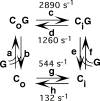The SLC2 (GLUT) family of membrane transporters
- PMID: 23506862
- PMCID: PMC4104978
- DOI: 10.1016/j.mam.2012.07.001
The SLC2 (GLUT) family of membrane transporters
Abstract
GLUT proteins are encoded by the SLC2 genes and are members of the major facilitator superfamily of membrane transporters. Fourteen GLUT proteins are expressed in the human and they are categorized into three classes based on sequence similarity. All GLUTs appear to transport hexoses or polyols when expressed ectopically, but the primary physiological substrates for several of the GLUTs remain uncertain. GLUTs 1-5 are the most thoroughly studied and all have well established roles as glucose and/or fructose transporters in various tissues and cell types. The GLUT proteins are comprised of ∼500 amino acid residues, possess a single N-linked oligosaccharide, and have 12 membrane-spanning domains. In this review we briefly describe the major characteristics of the 14 GLUT family members.
Copyright © 2012 Elsevier Ltd. All rights reserved.
Figures






References
-
- Abel ED, Peroni O, Kim JK, Kim YB, Boss O, Hadro E, Minnemann T, Shulman GI, Kahn BB. Adipose-selective targeting of the GLUT4 gene impairs insulin action in muscle and liver. [see comments] Nature. 2001;409(6821):729–733. - PubMed
-
- Abramson J, Smirnova I, Kasho V, Verner G, Kaback HR, Iwata S. Structure and mechanism of the lactose permease of Escherichia coli.[see comment] Science. 2003;301(5633):610–615. - PubMed
-
- Angulo C, Rauch MC, Droppelmann A, Reyes AM, Slebe JC, Delgado-Lopez F, Guaiquil VH, Vera JC, Concha II. Hexose transporter expression and function in mammalian spermatozoa: cellular localization and transport of hexoses and vitamin C. Journal of Cellular Biochemistry. 1998;71(2):189–203. - PubMed
-
- Anzai N, Ichida K, Jutabha P, Kimura T, Babu E, Jin CJ, Srivastava S, Kitamura K, Hisatome I, Endou H, Sakurai H. Plasma urate level is directly regulated by a voltage-driven urate efflux transporter URATv1 (SLC2A9) in humans. J Biol Chem. 2008;283(40):26834–26838. - PubMed
Publication types
MeSH terms
Substances
Grants and funding
LinkOut - more resources
Full Text Sources
Other Literature Sources

